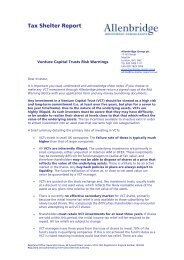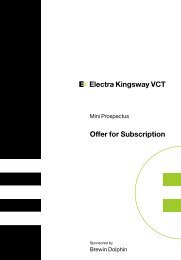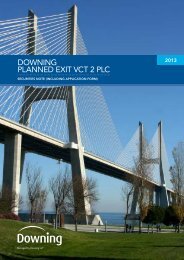Ventus VCT plc and Ventus 2 VCT plc - The Tax Shelter Report
Ventus VCT plc and Ventus 2 VCT plc - The Tax Shelter Report
Ventus VCT plc and Ventus 2 VCT plc - The Tax Shelter Report
Create successful ePaper yourself
Turn your PDF publications into a flip-book with our unique Google optimized e-Paper software.
Asset allocation<br />
<strong>The</strong> Manager will seek to maximise, so far as practicable, each Company’s investment in equity securities <strong>and</strong> loan stock of companies owning<br />
renewable energy projects with Full Consent, ready for construction of the project to commence or whose assets are already operational. Up<br />
to 10% of the net proceeds of the initial share offers <strong>and</strong> the Offers may be allocated to development funding for early stage renewable energy<br />
projects prior to Full Consent being obtained.<br />
Each Company’s policy is to maintain cash reserves of at least 5% of Net Proceeds <strong>and</strong> the net proceeds of the initial share offers for the<br />
purpose of meeting operating expenses <strong>and</strong> purchasing their shares in the market. Circumstances may arise which will require the Companies<br />
to hold less than 5% of the net proceeds in cash for a limited period of time.<br />
In order to comply with <strong>VCT</strong> requirements, at least 70% by value of each of the Company’s investments are required to be comprised of<br />
Qualifying Investments.<br />
<strong>The</strong> Companies will typically invest up to £2 million in equity <strong>and</strong> loan stock in each investee company with no more than £1 million invested<br />
in an investee company in any single tax year. <strong>The</strong> Companies typically own 25% to 50% of the equity share capital of each investee company<br />
<strong>and</strong> a portion of their investment in each investee company may be in the form of loan stock.<br />
<strong>The</strong> Companies’ uninvested funds are placed on deposit or invested in short-term fixed income securities until suitable investment opportunities<br />
are found.<br />
Risk diversification<br />
<strong>The</strong> geographical focus of the portfolio is in the UK market due to <strong>VCT</strong> requirements. This risk is mitigated by making investments in a wide<br />
geographical spread of projects that are situated throughout the UK. Funds are also invested with a range of small-scale independent<br />
developers so project risk is not concentrated with only a few developers. <strong>The</strong> portfolio contains projects at different stages of the asset<br />
lifecycle, ranging from pre-planning to construction <strong>and</strong> then into operation. Investments are made via subscriptions for new share capital or<br />
via loan stock instruments in order to secure a negotiated level of return from the project. <strong>The</strong> majority of investments are made in special<br />
purpose companies set up specifically to develop each project <strong>and</strong> any bank debt financing will normally be non-recourse to the Companies.<br />
<strong>The</strong> returns from projects are largely dependent on the UK Government’s continued support for renewable energy, primarily under the RO.<br />
<strong>The</strong> effects of any negative change to this policy should be mitigated by the UK Government’s historic practice of gr<strong>and</strong>fathering financial<br />
support mechanisms for existing assets. This risk is further mitigated by the Companies typically negotiating fixed <strong>and</strong>/or floor price mechanisms<br />
into the PPAs entered into by project companies for the sale of their generated output.<br />
Gearing<br />
<strong>The</strong> Companies have no present intention to borrow funds for investment purposes. However, the Companies are exposed to gearing through<br />
their investee companies which typically fund the construction costs of each project through senior bank debt finance. <strong>The</strong> Manager will be<br />
involved in negotiating the terms of this finance to ensure competitive terms are achieved. <strong>The</strong> interest rate is typically fixed through an interest<br />
rate swap for the duration of the bank loan so the projects are not exposed to changes in market interest rates. To the extent that borrowing is<br />
required, the Directors shall restrict the borrowings of the Companies, <strong>and</strong> shall so far as possible by the exercise of the Companies’ voting<br />
powers in <strong>and</strong> other rights or powers of control over its subsidiaries secure that they restrict their borrowings, so that the aggregate principal<br />
amount at any time outst<strong>and</strong>ing in respect of money borrowed by their group shall not without the previous sanction of an ordinary resolution<br />
of the Companies exceed a sum equal to 10 % of the adjusted share capital <strong>and</strong> reserves of the Companies in accordance with their Articles.<br />
Maximum Exposures<br />
In order to gauge the maximum exposure of the Companies to various risks, the following considerations apply:<br />
i) Investments in Qualifying Investments<br />
70-95% of funds will be invested in qualifying holdings no later than three years after the date that provisional approval by HMRC of<br />
each of the Companies’ status as a <strong>VCT</strong> becomes effective. <strong>The</strong> relevant compliance date for the initial ordinary share offer was 1 March<br />
2009 <strong>and</strong> for the initial ‘C’ Share offer is 1 March 2012. Should the holdings inadvertently fall below this level after the relevant date then<br />
this will be remedied within six months as permitted by the <strong>VCT</strong> Rules.<br />
ii) Concentration Limits<br />
Under the <strong>VCT</strong> Rules no more than 15% of the Companies’ total assets should be in a single investee company at the time the investment<br />
is made in that investee company.<br />
iii) A maximum of 10% of the net funds raised from the initial ordinary share offer, the initial ‘C’ Share offer <strong>and</strong> the Offers may be invested<br />
in pre-planning projects.<br />
11

















